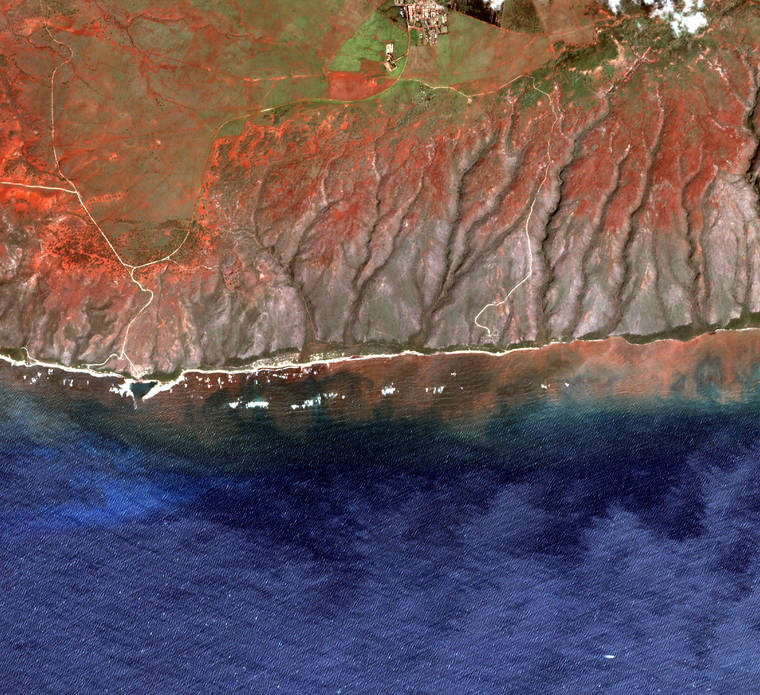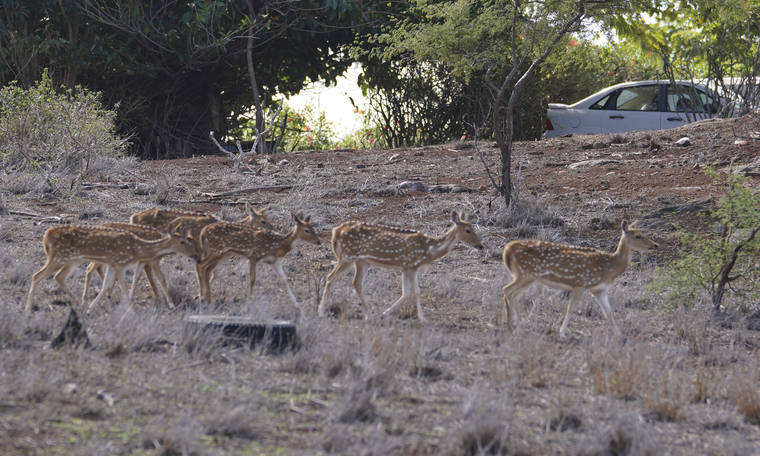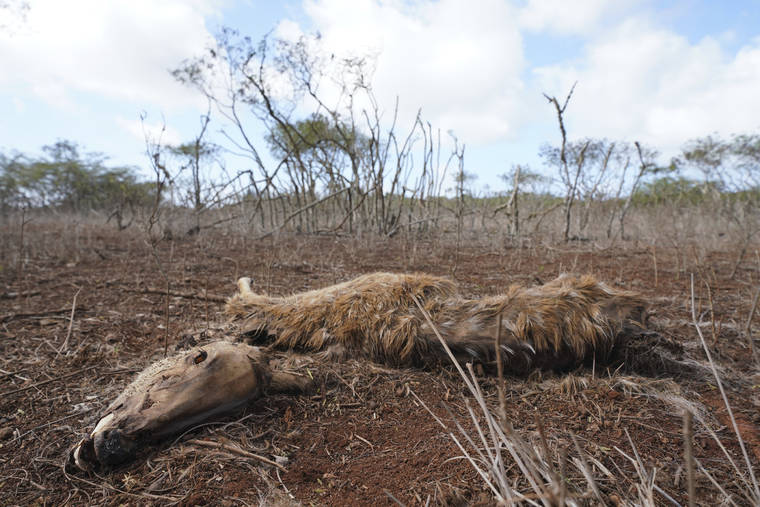Drought causing axis deer starvation, death on Molokai

In this undated 2020 satellite image, runoff from the island of Molokai is shown flowing into the ocean. (Arizona State University’s Center for Global Discovery and Conservation Science, Allen Coral Atlas/via AP)

In this undated 2020 aerial photo provided by the Arizona State University's Global Airborne Observatory, runoff from the island of Molokai is shown flowing into the ocean. (Global Airborne Observatory, Arizona State University via AP)

Axis deer walk through an opening in Maunaloa, Molokai, on Jan. 15. Axis deer, a species native to India that were presented as a gift from Hong Kong to the king of Hawaii in 1868, have fed hunters and their families on the rural island of Molokai for generations. But for the community of about 7,500 people where self-sustainability is a way of life, the invasive deer are a cherished food source but also a danger to the island ecosystem. Now, the proliferation of the non-native deer and drought on Molokai have brought the problem into focus. Hundreds of deer have died from starvation, stretching thin the island’s limited resources.

An axis deer, dead in a field Jan. 15 on Molokai. (Photos by Cory Lum/Honolulu Civil Beat via AP)

Resident Walter Ritte walks past dead axis deer in a large pit on Jan. 15 on Molokai. (Cory Lum/Honolulu Civil Beat via AP)

This image provided by Honolulu Civil Beat shows axis deer grazing in a field near Hoolehua, Molokai, on Jan. 15. Axis deer, a species native to India that were presented as a gift from Hong Kong to the king of Hawaii in 1868, have fed hunters and their families on the rural island of Molokai for generations. But for the community of about 7,500 people where self-sustainability is a way of life, the invasive deer are a cherished food source but also a danger to the island ecosystem. Now, the proliferation of the non-native deer and drought on Molokai have brought the problem into focus. Hundreds of deer have died from starvation, stretching thin the island's limited resources. (Cory Lum/Honolulu Civil Beat via AP)

In this undated 2020 aerial photo provided by the Arizona State University’s Global Airborne Observatory, runoff from the island of Molokai is shown flowing into the ocean. (Global Airborne Observatory, Arizona State University/via AP)
HONOLULU — Axis deer, a species native to India presented as a gift from Hong Kong to the king of Hawaii in 1868, have fed hunters and their families on Molokai for generations. But for the community of about 7,500, where self-sustainability is a way of life, the invasive deer are both a cherished food source and a danger to their island ecosystem.
HONOLULU — Axis deer, a species native to India presented as a gift from Hong Kong to the king of Hawaii in 1868, have fed hunters and their families on Molokai for generations. But for the community of about 7,500, where self-sustainability is a way of life, the invasive deer are both a cherished food source and a danger to their island ecosystem.
Now, drought on Molokai has brought the problem into focus. Hundreds of deer have died from starvation, stretching thin the island’s limited resources.
The drought is among the island’s worst in recent memory and has been going on for nearly two years.
“During the last wet season, which in Hawaii runs from October through April, it never pulled out of drought,” said U.S. National Weather Service hydrologist Kevin Kodama. “It’s been pretty bad, especially for pasture conditions and just the general vegetation. … It’s had an impact on the wildlife.”
In India, axis deer are kept in check by tigers and leopards. But with no natural predators on Molokai, the population has exploded, and there now are an estimated 50,000 to 70,000 deer on the 260 square mile island.
Residents have a hard time controlling the population by hunting alone. And the animals, in desperate search for food and water, are destroying crops and forest watershed people rely on for food and drinking water.
When the deer devour fruits, vegetables and other plants, it leads to erosion and runoff into the ocean that alters the island’s coral reef — another important food source.
“Molokai has the longest continuous fringing reef in the United States, and it’s one of our community’s greatest assets,” said Russell Kallstrom, information coordinator for the Nature Conservancy’s Molokai program. “When ungulates overpopulate an area, that erosion impacts not just the reef, but people’s lifestyle and the subsistence lifestyle that’s there.”
The reefs around Molokai are getting more runoff and sedimentation than expected and at least part of it is caused by erosion from the deer, said Greg Asner, a Hawaii-based marine ecologist.
Sedimentation that settles on the coral can kill it, said Asner, who heads Arizona State University’s Center for Global Discovery and Conservation Science. “Fish, invertebrates like crabs, lobsters, you name it — they all rely on that same habitat.”
The deer problem has persisted for years but is getting worse, according to Glenn Teves, a Molokai native and the University of Hawaii’s county extension agent for the island.
“They started moving into the farm area and are just raising hell,” said Teves, who owns a small farm on Molokai.
“It’s a perfect storm,” he said. “What farmers did was they started fencing off their areas, but not all farmers could afford the fencing. So you may be protecting yourself, but you’re just pushing the deer into the another farmer’s place.”
Options for controlling the population include more hunting, aerial sniping and fencing that protects certain areas. Sterilizing deer is difficult and expensive, and no one wants to poison or eradicate them.
If healthy deer are killed, slaughter houses could process the meat into hamburger for food banks and others in need, Teves said. Even composting the carcasses of unhealthy animals has been considered, he said, “so we can use it to bring the land back.”
Gov. David Ige recently issued an emergency disaster declaration for Maui County, which includes Molokai, so the state could “take immediate measures to reduce and control the axis deer populations and to remove and dispose of the carcasses quickly.”
Maui County Mayor Michael Victorino said the disaster proclamation also can help unlock state and federal funding to mitigate some financial losses.
“Our agricultural sector has sustained substantial pasture and crop damage from axis deer in search of food,” he said.
Maui County recently set aside $1 million to address the problem, splitting it among Molokai and two other islands — Maui and Lanai — where axis deer were brought in the 1950s and now are damaging farms, ranches and forests.
A bill last year to allocate another $1 million died in the state Legislature after pushback from Molokai residents who feared the deer would be wiped out. State lawmakers are again trying pass a measure for funding to help manage the deer.
“They trample sea bird burrows, and their grazing and trampling causes soil erosion, causing siltation of reefs that support fish people eat as well, and ultimately, watersheds and fresh water production,” said Jeff Bagshaw, an outreach specialist for the state’s Division of Forestry and Wildlife in Maui County.
Hunting can help control the deer, but Bagshaw says hunters tend to shoot bucks, which increases “harem-size” and doesn’t do much to decrease the overall population.
In 2019, fewer than 400 residents on Molokai were issued hunting permits, he said. Statewide the number was about 10,600. Nearly 1,500 permits were issued to nonresidents, many who come to Hawaii specifically to hunt, but coronavirus restrictions in 2020 meant far fewer people came to the state for leisure.
Because of the overpopulation, there is no daily bag limit on deer nor a designated hunting season.
A number of other nonnative species have become established in the islands, including goats and pigs. According to the U.S. Fish and Wildlife Service, the hoofed animals are among the largest contributors to ecosystem degradation and extinction in Hawaii, where plants and animals that evolved in isolation over millions of years lack natural defenses against introduced species.
In addition to causing to environmental damage, the starving deer population has become a public nuisance. Dead ones are rotting around the island, including along shorelines where people fish, swim and surf.
Private landowners are responsible for disposing of dead deer on their property, while state and county agencies have to clean up dead deer on public lands.
And people who regularly drive on Molokai say the normally skittish deer have become more brazen while seeking food and water and pose a serious roadway hazard.
“Just driving down the highway, herds will suddenly decide to cross, and so a lot of people have had their vehicles totaled as a result of impacts with deer,” Kallstrom said.
Hawaii County successfully eradicated axis deer in 2017, nearly eight years after the animal was introduced to the Big Island. The declaration came after no confirmed sightings of the deer since the last one was killed five years prior in Ka‘u.
A U.S. Fish and Wildlife investigation traced the ungulates introduction to a Mountain View man, a rancher and a pilot from Maui who arranged a sheep-for-deer swap between the islands in late 2009. The men said they wanted to create another hunting resource on the island.
The trio were convicted for possessing game animals without a permit.
West Hawaii Today staff contributed to this report.


